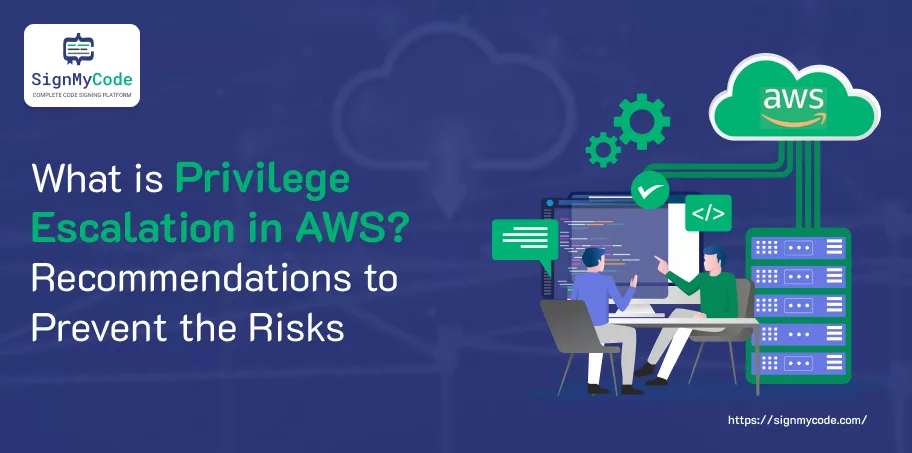What is Privilege Escalation in AWS?Recommendations to Prevent the Risk of Privilege Escalation on AWS

What is Privilege Escalation in AWS?
Privilege escalation in AWS refers to the unauthorized elevation of user privileges within the AWS environment, allowing users to access resources and perform actions beyond their intended level of permissions.
This security risk would arise in case the attackers utilize the vulnerabilities or misconfigurations in AWS services, IAM policies, or access controls to take up privileges above the current level.
For example, an attacker might compromise a low-privileged user account and then exploit weaknesses in IAM policies or misconfigured permissions to escalate their privileges and gain access to sensitive data, modify infrastructure configurations, or perform malicious actions within the AWS environment.
Recommended: What Is Privilege Escalation? How to Detect and Prevent Privilege Escalation Attacks in Windows
Putting in place unauthorized account access in AWS implies possible data breaches, service failure, or money losses.
Therefore, it is crucial for AWS users to implement robust security measures, such as regularly reviewing and updating IAM policies, adhering to the principle of least privilege, implementing multi-factor authentication (MFA), and monitoring and logging AWS API calls.
This is for suspicious activities and conducting regular security audits and assessments to detect and mitigate potential privilege escalation vulnerabilities.
How to Implement Least Privilege in AWS?
Implementing the principle of least privilege in AWS is crucial for maintaining a strong security posture and minimizing the risk of unauthorized access or data breaches. Here’s a detailed explanation of how to achieve this:
Use IAM Policies:
AWS IAM (Identity and Access Management) enables you to authorize the policies that specify user accounts, groups, or roles that can have access to the AWS resources.
When creating IAM policies, it’s essential to be as granular as possible, granting only the permissions necessary for users to perform their specific tasks. Don’t utilize very relaxing rules that give wide purchases to AWS resources.
Assign Roles:
Instead of directly assigning permissions to individual IAM users, it’s best practice to assign roles based on users’ responsibilities or job functions.
The essence of this method is to make it easier to oversee permissions, not to deploy the principle of least privilege more properly. Users assume roles temporarily, gaining access only to the resources associated with their role during that time.
Create Custom Policies:
Although AWS features managed policies that contain predefined sets of permissions, the organizations are frequently dedicated to creating IAM custom policies designed for their unique situations.
Start with minimal permissions and gradually add additional permissions as needed, following the principle of least privilege. Monitor policies periodically and revise them timely in such a way that their goals still fit the business.
Regularly Review Permissions:
Periodically review IAM policies and permissions to identify and remove any unnecessary or outdated permissions.
AWS has tools like IAM Access Analyzer, which evaluates resource policies, identifies mistaken access, and helps make sure enough privileges are granted to the user and no more.
Enable Multi-Factor Authentication (MFA):
Enforce multi-factor authentication (MFA) for IAM users, particularly for those with elevated privileges or access to sensitive resources.
An MFA further expands the already existing security by requiring users to provide not only one but a method of two-factor authentication used for producing the one-time password, which is done through either a hardware token or mobile app in the end along with the password.
Utilize AWS Organizations:
AWS Organizations enables you to centrally manage policies and permissions across multiple AWS accounts within your organization.
With the service control policies (SCPs) that have organization level, you can be ensured that the security policies and the least privilege principles will be enforced unchangingly and across all member accounts.
Monitor and Audit:
Implement logging and monitoring for AWS API calls and user activity using services such as AWS CloudTrail and Amazon CloudWatch.
These tools enable you to get visibility on user actions, detect unauthorized attempts to gain access and provide essential support in complying with the principle of least privilege.
Preventing Privilege Escalation in the AWS Environment
To prevent privilege escalation in the AWS environment, several effective strategies can be implemented based on information from various sources:
Implement Least Privilege Access
As seen from the Principle of least privilege (PLOP), which is cardinal for a safe AWS environment. This axiom suggests that only the minimum access and the permissions granted to each individual or machine are sufficient in fulfilling their obligations.
Thus, the planting of only required data in the system helps to create a safe environment and reduces the chance of penetrating the system without authorization.
Utilize AWS Managed Policies
AWS has managed role-based labels for the administrator, developer, or data scientist job functions. These role-based access policies consist of predefined sets of permissions that define the access permissions of a normal organization’s role.
With this, organizations will be in the convenient position of assigning the right levels of managed policies to users and roles based on their system responsibilities.
This will enable them to ensure their staff have access to only the resources they need without being too excessive on the permissions.
Regularly Review and Remove Unnecessary Permissions
Using the IAM Access Analyzer, companies will be able to differentiate and deauthorize what is not needed in IAM policies. Access Analyzer will analyze resource permissions to drill out of those situations that are highly permissive, and it comes up with remediation suggestions.
Periodically taking a moment to recheck and polish the IAM policies is a perfect way to ensure that untrusted users and roles only have access to the data they need for their tasks, thus inhibiting the risk of an impermissible action.
Generate Policies Based on CloudTrail Events
CloudTrail logs give good tracking and take the activities of users and API calls done inside an AWS environment. Organizations thereby exploit the potential to create a comprehensive list of permissions roles for users and roles using the actual happening of them.
Organizations can determine the IAM policies that are going to be implemented based on real practical usage of the permissions assigned through analyzing CloudTrail events, and thus, they make sure that only permissions that are used properly are authorized.
Utilize IAM Access Analyzer for External Threat Detection
IAM Access Analyzer has another security function, as it can detect incoming external threats from those users who have more than the necessary permissions. As well as admins shelling out IAM access, Access Analyzer extends further to do for federated user permissions and access levels.
By preventing the possibility of over-permissiveness transactions and privilege escalation beforehand the company removes the access threat and privilege escalation risk.
Understand AWS Lambda Privilege Escalation Risks
Awareness of privilege escalation risks that might occur in the AWS Lambda functions must be ensured by the organizations. Hackers can attempt privilege escalation by abusing wrongly configured IAM roles that are exploited by malicious actors.
Recommended: What is Lambda Code Signing?
A risk management strategy that uses this IoT application is for the organizations to implement IAM governance models that are correctly configured to restrict access and prevent unauthorized actions within the Lambda functions.
Recommended: How to Configure your Code Signing for AWS Lambda?
Consider Anomaly Detection Tools
With the Splunk Lantern anomaly detection tool able to differentiate the privilege escalation anomalies within the AWS environment, organizations have an advantage.
These tools understand users’ information, API calls as well as requested URLs for suspicious events that might indicate that unauthorized access or privilege escalation took place.
Through the application of monitoring abnormal behavior, companies can run spot checks and quickly detect and counter security threats in the early stage before they develop into more serious problems.
Conclusion
Disallowing the escalation of privileges in an AWS environment is key for sustaining the integrity and security of the cloud environment.
With an advanced security infrastructure and using standard methodology, a company can greatly eliminate the danger of illegal entry, data leakage, and malicious actions.
The Least Privilege principle plays an instrumental role in this area, along with regularly reviewing and updating IAM policies, enabling multi-factor authentication, and implementing tools such as AWS Managed Policies and IAM Access Analyzer, which are all obligatory steps in addressing privilege escalation risks.
Furthermore, learning the issues that may be encountered, as well as employing anomaly detection with the interaction of these tools, can further be helpful to strengthen our security posture and provide early detection of risks.
Preventive action in the form of knowing the present security threats and vulnerabilities can help organizations stay aloof from such attacks, and thus, they are able to secure their cloud environments and sensitive information and resources.


